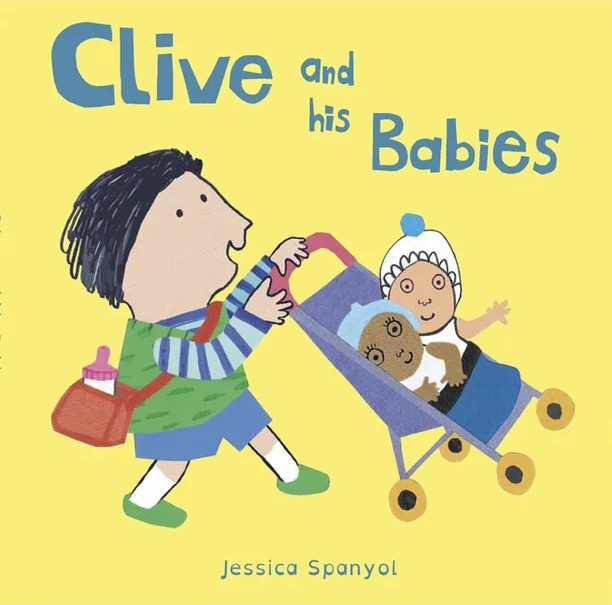
Inclusive Children's Book Teaching Guide
Clive and His Babies
What is this book about?
In this gentle, affectionate book—which celebrates diversity and challenges gender stereotypes—Clive tenderly cares for his two baby dolls as depicted on the cover.
Clive loves his dolls. He enjoys playing with them and sharing them with his playmates. Clive and his friends give the dolls stroller rides, feed them meals, dress them up, teach them how to use the potty and tuck them into their cardboard box bed.
A refreshing departure from children's stories that are too often implicitly or explicitly gendered, Clive and His Babies is a total delight!
Who is depicted in this book?
- Children who transcend gender stereotypes about toys and forms of play
What early childhood themes and concepts does this book explore?
- How to "care for" a baby doll, learned through pretend play
How does this book support anti-bias education?
Clive and His Babies highlights Clive's awareness of his play preferences and his self-confidence as he shares his dolls with various friends. Clive's play and toy choices represent a range of activities that move beyond gender stereotypes.
Depending on how the book is shared or used—and the developmental levels of the children—Clive and His Babies may be used to support the following core goal from Anti-Bias Education for Young Children and Ourselves:
Identity—Teachers will nurture each child’s construction of knowledgeable and confident personal and social identities so that children will demonstrate self-awareness, confidence, family pride and positive social identities.
How can this book be used to meet early childhood learning standards?
For all ages
Use Clive and His Babies to meet early childhood literacy standards >
For children from birth to age three
Teaching suggestion: Model different aspects of the babies’ daily routine—such as feeding, splashing, dressing and reading—while looking through the book. This can be done by imitating actions from the book, with or without a baby doll.
What Illinois Early Learning Guideline does this meet for children from birth to age three?
Developmental DomainCognitive Development
Standard: Symbolic ThoughtChildren demonstrate the understanding of concepts, experiences, and ideas through symbolic representation.
Indicators for children:
- Engages in simple pretend play, such as pretending to feed a baby doll with toy bottle (7–18 months)
- Engages in pretend play with familiar objects and experiences (16–24 months)
- Builds in sequencing while engaged in play, such as getting a baby doll dressed to go outside, feeding the doll or putting the doll to bed (21–36 months)
Teaching suggestion: Point out the familiar forms of play that even the youngest children can react to, point at or name.
What Illinois Early Learning Guideline does this meet for children from birth to age three?
Developmental DomainSocial-Emotional Development
Standard: Relationship with PeersChildren demonstrate the desire and develop the ability to engage and interact with other children.
Indicators for children:
- Begins to engage in parallel play, in closer proximity to other children but no interaction is attempted (7–18 months)
- Begins to engage in simple reciprocal interactions, such as rolling a ball back and forth (16–24 months)
- Demonstrates a preference for select peers (21–36 months)
For preschoolers (ages three to five)
Teaching suggestion: Clive and his friends care for their dolls in a variety of ways, acting out many different activities. Have children discuss the different actions that they see in the book and then act out ways to care for baby dolls in the dramatic play area. You can also incorporate dolls into a book share!
What Illinois Early Learning and Development Standards does this meet for preschoolers?
The Arts Standard25AInvestigate, begin to appreciate, and participate in the arts.
Benchmark 25.A.ECb:
Drama: Begin to appreciate and participate in dramatic activities.
See inside this book.

